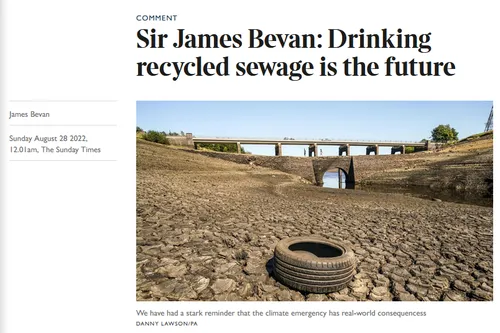
The head of the UK’s Environment Agency, who is linked to the World Economic Forum, says that common people need to be “less squeamish” about drinking “toilet-to-tap” water from sewage plants, as countries and states around the world move towards recycling sewage for human consumption, falling into lockstep with WEF ideology.
According to an op-ed in The Times, Sir James Bevan, whose views have previously been disseminated by the WEF, writes that “drinking recycled sewage is the future.”
The idea of recycling wastewater for human consumption — once the realm of dystopian sci-fi films — is gaining traction globally as the WEF penetrates governments.
“The recent rainfall hasn’t changed the underlying position in this country: many parts are likely to stay in drought for months, and if we have a dry winter then next year will be even more challenging,” Bevan writes. “We will need to be less squeamish about where our drinking water comes from. Part of the solution will be to reprocess the water that results from sewage treatment and turn it back into drinking water — perfectly safe and healthy, but not something many people fancy.”

Sir Bevan’s op-ed comes as US water supplies are under strain due to an ongoing, and worsening drought which has resulted in ten areas being given drought status by the Environment Agency.
Because of this, Sir Bevan says that common people need to “change the way they think about water,” and “treat it as a precious resource, not a free good.”
“If we are going to get there, we are all going to have to think differently. Some of these measures will be unpopular, so future governments will need to show political will,” he said.
Earlier this year, Singapore’s water agency launched a beer made with recycled sewage in order to raise awareness over the country’s water security issues (and probably to mask the taste of poo).
Zero Hedge report that Los Angeles County is threatening a similar move to recycle wastewater for human consumption.
“There’s been a public health legacy where sanitary engineering practices and regulators considered sewage a waste, it was something to be avoided, something to be feared,” said Brad Coffey of the Metropolitan Water District of Southern California. “Now that we have the technology… the public, the regulators, the scientific community has much greater confidence in our ability to safely reuse that water supply.”
The plan hinges on the State Water Resources Control Board, which legislators have tasked with developing a set of uniform regulations by December 31 which would govern potable reuse.
“This is going to be the future of L.A.’s water, the future of the state’s water supply,” said Gonzalez, who added that the Headworks project could come online within the next five years.
LA’s plans are much bigger than that, however – as the city has set out to recycle 100% of its wastewater by 2035 per a pledge made by Mayor Eric Garcetti several years ago.
In order to achieve this, LA’s Hyperion Water Reclamation Plant – which currently only treats wastewater so it’s clean enough to release into Santa Monica Bay – must be completely converted into an advanced water purification facility which produces water that’s clean enough to consume.
What else are you going to use to wash the bugs down, after all?
Source: newspunch.com